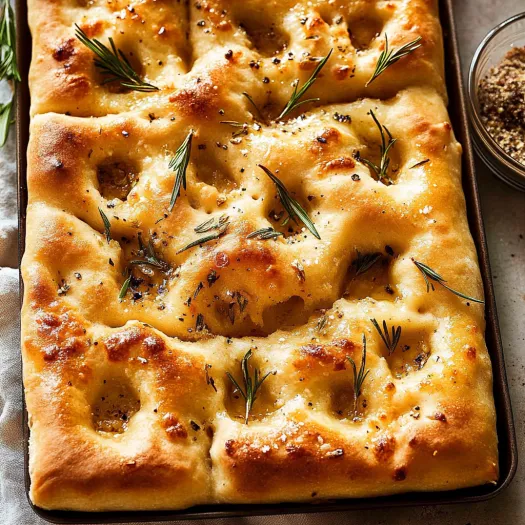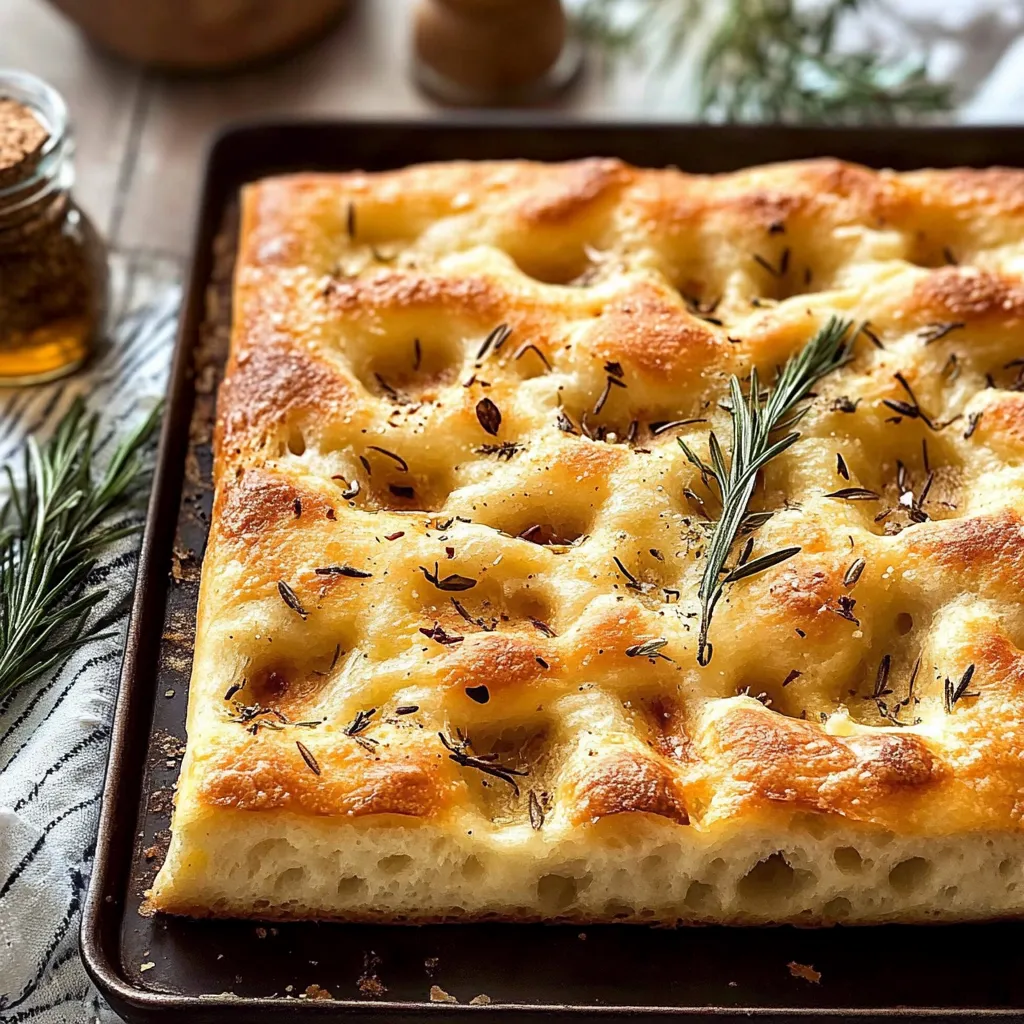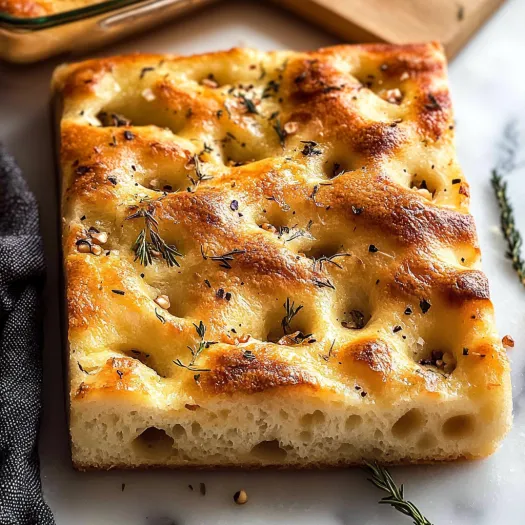 Pin it
Pin it
Focaccia Barese brings together a fluffy middle and crisp outer crust, making every bite a classic Italian bread treat. The secret ingredient here is potato—it makes the bread extra tender and chewy, pretty much impossible to stop eating. Instead of being complicated, this famous Bari bread turns ordinary things into something amazing, just by doing things the right way and letting time do the work.
I bumped into this dish when I was traveling through the south of Italy—a sweet grandma brought a bunch of us into her kitchen. She barely spoke a word I could understand, but you could follow her moves perfectly. After trying it at home, I felt like I was right back in her sunny kitchen with the smell of olive oil and the sound of everyone chatting. When I make this for my friends now, they always ask how they can make it too.
Irresistible Ingredient Choices
- Cherry tomatoes: They get juicy and sweet in the oven, plus make it look extra inviting
- Warm water: Use water around 40°C—just right to wake up the yeast and still keep the good bacteria alive
- Sea salt: Adds big flavor inside and leaves a tasty crunch on top when sprinkled before popping it in the oven
- Instant yeast: Helps dough rise every time, no need for fussy activation steps
- Extra virgin olive oil: Packs in that classic Mediterranean taste and helps the crust get super crunchy
- Bread flour: Lets the dough hold plenty of moisture while giving the bread good stretch
- Mashed potato: Makes the inside pillow-soft and gives the yeast something extra to munch on
Simple Steps for Success
- Baking Time:
- Put the pan in the center of the oven preheated to 220°C. Let it bake for about twenty-five minutes till the top turns a rich brown and those edges get nice and crisp. Give the bottom a tap—if it sounds hollow, you nailed it. Move it straight to a cooling rack so steam doesn't wreck the bottom.
- Putting it All Together:
- Spoon the dough into your prepped pan. Gently stretch it towards the sides with oiled hands, but don't pull too hard—you want to protect that tender structure. Let it stop just shy of the edges, since it'll puff up soon. Loosely cover again and give it about forty more minutes in a cozy spot till it looks puffy and full of bubbles just under the surface. Now it's good to go for the fun stuff.
- First Rise:
- With your hands just a little wet so nothing sticks, fold the dough in on itself. Try to smooth it out, even though it's super sticky. Shape into a soft ball, throw on some plastic wrap or a damp towel, and let it hang out for half an hour in a warm spot (about 24°C). Once it changes shape and has bubbles, you're ready for the next move.
- Mixing the Dough:
- Cook up one decent-sized potato in boiling water till a fork goes in easy—takes about twenty minutes based on size. Drain and mash it smooth. Dump 500 grams bread flour into a big bowl, toss in instant yeast, a bit of salt, and sugar. Whisk it all so it's even. Make a dip in the middle, pour in the warm water and some olive oil. Use a spoon to bring it together till it's messy, then stir in your mashed potato completely.
- Ready, Set, Top:
- Use your fingers to poke deep dimples all over once it's risen again—don't hold back. Drizzle more olive oil so it pools in those dents. Pop on the toppings however you like—tomatoes cut side up, scattered olives, or swirl on garlic oil, followed by fresh herbs. Sprinkle plenty of sea salt over it all for that craveable finish.
- Second Rise/Folding:
- Move the dough into a fresh bowl with a solid layer of olive oil so it slides out later. Grab the far edge, stretch it up, then fold toward the center—turn the bowl and repeat, making your way around until you've folded all sides. Cover it up and let it chill again for another thirty minutes somewhere warm. The dough will get stronger and taste even better at this point.
- Pan Set Up:
- Grab a metal pan around 26 x 20 centimeters for just the right thickness. Pour a good glug of olive oil over the bottom and corners so nothing sticks. While it rests, get your toppings ready—slice tomatoes, weigh out olives, and make a garlic oil by gently warming garlic in olive oil. Rinse herbs so they're fresh for the last step.
 Pin it
Pin it
My love for potato focaccia comes from watching my Italian neighbor make it during community get-togethers when I was a kid. She told me that tough times made them stretch flour with potatoes, which also made the bread better. Turning something practical into something delicious stuck with me, and every time I mash that potato into the dough, I feel like I'm bringing a bit of old-school wisdom to the table with modern flair.
Tasty Pairing Ideas
Slice and serve this beauty warm with a bowl of balsamic and your best olive oil for a snack that feels fancy. Lay out some prosciutto and mozzarella so folks can build their own little sandwiches for a laid-back vibe. When it's hot out, pair it with cool gazpacho in small glasses for the freshest summer setup.
Local Twists to Try
Feel like mixing it up? Spread caramelized onions before baking for that sweet Northern Italy flavor. Cube up some aged pecorino and tuck it into the dough so you hit pockets of melt-in-your-mouth cheese. Or take the Ligurian route—lay over thin potato slices, a bit of rosemary, and flaky salt for a perfect pick-me-up next to roasted meat in the fall.
Keeping it Fresh
Make sure it's totally cool, then wrap it in parchment and a kitchen towel for max freshness (good for about two days). If it's a bit old, sprinkle with a little water and put in a 160°C oven for 10 minutes to get that crisp back. Slice leftovers crosswise for open sandwiches with all your Mediterranean favorites. You can even freeze single pieces for a month—just thaw and warm up to make it taste like new.
 Pin it
Pin it
This Focaccia Barese totally sums up why I adore classic Italian bread—it shows off what you can do with basic ingredients just by knowing the right moves. I’ve realized that the old-school versions are way simpler than new ones, but making each step count is what makes the magic. Figure out proofing, keep the dough wet enough, and watch the temp—don’t fuss with extra stuff. Whether I serve it with a plain soup or start a big dinner with it, the old-world charm of this bread never fails to connect everyone at the table to something bigger.
Frequently Asked Questions
- → Why does this focaccia recipe include potato?
- Potato in the dough locks in extra moisture and makes the crumb super tender but the outside still turns crunchy. It’s a trick Italians use for bread that stays soft days later.
- → Can I use all-purpose flour instead of bread flour?
- Go ahead and swap in all-purpose flour if you have to. The texture will be a bit softer, not as bouncy as when you use bread flour though. Guests might like the chew best if you stick with bread flour.
- → Why do I need to make dimples in the focaccia dough?
- Pressing in little dents isn’t just for looks. The dip spots catch plenty of olive oil and keep your bread from puffing up like a pillow when it bakes.
- → Can I prepare the focaccia dough ahead of time?
- Honestly, this bread is tastiest the day it’s made. Chilling it for several days makes your dough lose some rising power, which makes for heavier bread.
- → How should I store leftover focaccia?
- Pop leftover focaccia in a zip bag for a few days at room temp. If you want that fresh crunch, warm it up a couple minutes in the oven and the inside will be fluffy again.
- → Why do you need to cook the garlic in oil before using it as a topping?
- If you put raw garlic right on top before baking, it’ll burn fast. Poaching it slowly in oil (that’s what confit is) means the garlic turns sweet, soft, and golden, not burnt.
